Characteristics
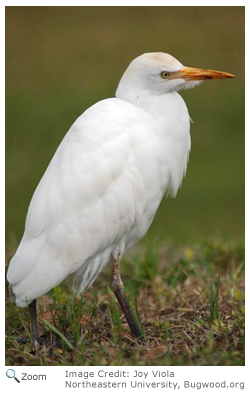 The cattle egret is a small white heron about 19-21 inches in length with a wingspan of about three feet. It often looks like it is hunched over. It has short legs and a thick neck compared to other species of egrets. The cattle egret is a small white heron about 19-21 inches in length with a wingspan of about three feet. It often looks like it is hunched over. It has short legs and a thick neck compared to other species of egrets.
Adults have dull yellow or orange bills and dull orange legs. Immature cattle egrets have black legs and bills.
During breeding season it has a brownish crown and chest and its eyes, legs and bill are red.
Range
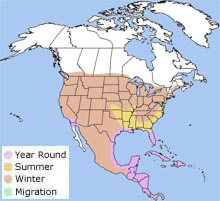 The cattle egret breeds from California east to the Great Lakes and Maine and south to the Gulf Coast. It is also found in the tropics, South America, Europe, Asia, Australia and Africa. The cattle egret is a non-native species in North America. It probably flew to South America from Africa and then moved up to the United States. The cattle egret breeds from California east to the Great Lakes and Maine and south to the Gulf Coast. It is also found in the tropics, South America, Europe, Asia, Australia and Africa. The cattle egret is a non-native species in North America. It probably flew to South America from Africa and then moved up to the United States.
Habitat
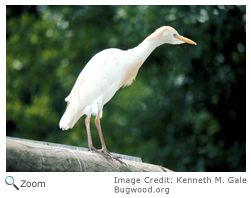 The cattle egret is most often found near farmland and livestock. It also can be found in wetlands. The cattle egret is most often found near farmland and livestock. It also can be found in wetlands. |
|
Diet
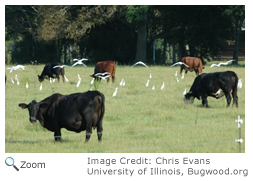 In Africa, the cattle egret eats insects that are stirred up by wild animals. They have adapted to following animals like cows in North America and eating insects like grasshoppers, crickets, spiders, and flies that are disturbed by the livestock.
Life Cycle
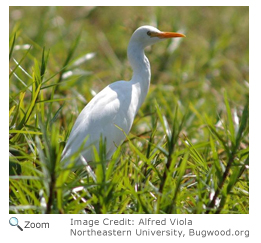 Males claim territory before mating begins. They will go through a variety of display behaviors to attract females. Females will gather in their territory and sometimes jump on the backs of the males. Eventually, the male will evict all but one female. Both the male and the female work on building a nest. The male brings the materials, sometimes stealing sticks from the nests of other egrets. The female constructs the nest. The nest is made of sticks and is built in a bush or a tree. The female lays three to five eggs and both parents incubate the eggs. The chicks hatch in between three and four weeks and fledge when they are a month old. Both parents care for the chicks. Cattle egrets nest in colonies with other species of egrets.
Behavior
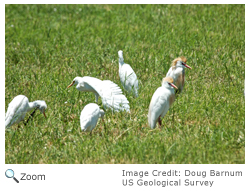 Cattle egrets are very social. They gather in large colonies of cattle egrets and other bird species. In addition to following livestock, they also follow farm equipment like tractors to catch insects that are disturbed.
|